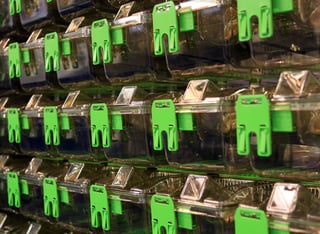 To most people, the term “vivarium” conjures up the image of a small fish tank-like glass box where a pet rat or gecko lives. While this is not incorrect, vivariums in biomedical research facilities are a bit more robust than what you might see in a high school science lab.
To most people, the term “vivarium” conjures up the image of a small fish tank-like glass box where a pet rat or gecko lives. While this is not incorrect, vivariums in biomedical research facilities are a bit more robust than what you might see in a high school science lab.
Vivarium Defined
Vivariums are enclosed areas designed to provide a stable environment for animals and plants for observation or scientific research. Often, vivariums contain a portion of an ecosystem for a particular species with controlled environmental conditions on a smaller scale. A vivarium you would find in an academic research setting contains multiple racks of various sizes depending on the species it contains.
Important Factors for a Vivarium
The essential purpose of a vivarium is to maintain a stable environment for the safety and comfort of the species and the personnel who work in these spaces every day. Therefore, the environment must be monitored and controlled at all times; even the smallest change can have a big impact, directly affecting the quality of research and the well-being of the specimens.
Humidity
Many plants and animals have either a limited tolerance or a necessity for high humidity. Imagine how susceptible humans are to swings in humidity: our eyes get irritated, our lips get chapped, our sinuses get inflamed among other annoyances (this is also why hospitals closely watch humidity, too).
CLICK HERE to see why other industries need to accurately monitor humidity.
Lighting
A lighting system is necessary to meet the requirements of many species and to better simulate the natural habitat. Solar energy is needed by many organisms to survive as it provides plants with nutrients and reptiles the additional heat they need. A day/night regulator may be needed to simulate light and dark periods to accurately create a natural environment.
Temperature/Climate
Many species cannot adapt to other temperature conditions outside of those found in its natural environment. Heating can be provided through different means, either through heating lamps or from the building HVAC system. In conjunction with lighting, temperature must be varied throughout the day, mimicking day/night cycles to keep living creatures’ circadian rhythms regulated.
Air Flow Systems
Ventilation systems are meant to:
- Stabilize the air flow between the holding room and vivarium
- Circulate fresh air
- Prevent the growth of mold and bacteria and spread of harmful bacteria
Air flow should be monitored with room pressure monitors with high accuracy to avoid airborne contaminants. Differential pressure is maintained between the interior of the vivarium area and adjacent corridors. In general, vivariums are positively pressured to keep the room free of outside contaminants; air pressure is higher inside the room that it is outside forcing contaminants out. However, during cleaning and sanitation cycles, room pressure is reversed and the area is negatively pressured.
CLICK HERE to learn how employees can contaminate other clean environments.


